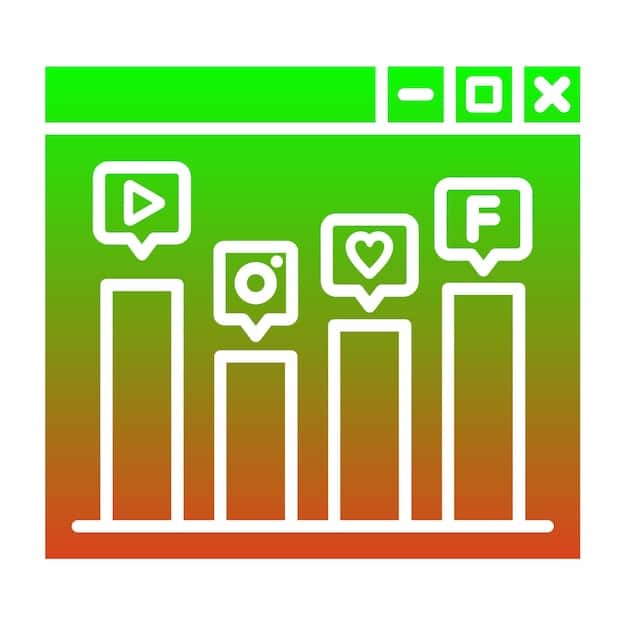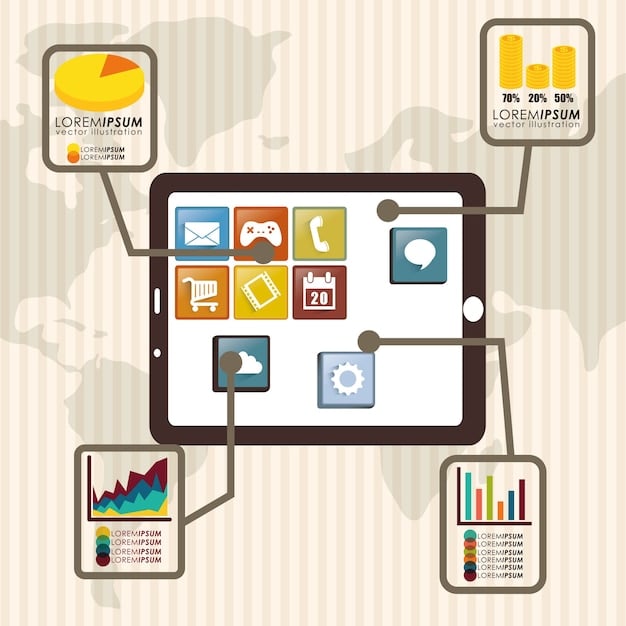Social Listening 2025: US Consumer Sentiment Analysis

Social listening in 2025 will leverage AI-powered tools and advanced techniques to provide businesses with deeper insights into US consumer sentiment, enabling highly targeted and personalized marketing strategies.
In the fast-evolving digital landscape, understanding consumer sentiment is crucial for businesses. This article explores how social listening in 2025: tools and techniques for understanding US consumer sentiment will leverage cutting-edge technologies to provide unprecedented insights into what US consumers think, feel, and want.
The Evolution of Social Listening
Social listening has drastically evolved from simple keyword monitoring to sophisticated sentiment analysis. In 2025, we can expect even more advanced capabilities that will revolutionize how businesses understand and interact with their target audiences.
Here’s how social listening has changed over the years:
Early Stages of Social Listening
Initially, social listening involved manual tracking of brand mentions and keywords. This process was time-consuming and often inaccurate, providing only a surface-level understanding of consumer sentiment.
The Rise of Sentiment Analysis
The introduction of automated sentiment analysis tools marked a significant leap. These tools use natural language processing (NLP) to analyze text and determine whether the sentiment is positive, negative, or neutral.

AI and Machine Learning Integration
Today, AI and machine learning enhance social listening by providing deeper insights and more accurate sentiment detection. These technologies can identify subtle nuances in language, understand context, and even predict future trends.
- Advanced NLP: AI-driven tools can now understand sarcasm, irony, and other complex linguistic structures.
- Predictive Analytics: Machine learning algorithms forecast consumer behavior based on historical data.
- Real-Time Insights: Instantaneous analysis of social media data allows for timely responses to emerging trends and crises.
In conclusion, the evolution of social listening has been driven by technological advancements, leading to more accurate, insightful, and actionable data for businesses. By 2025, these trends will only accelerate, making social listening an indispensable tool for understanding US consumer sentiment.
Key Social Listening Tools in 2025
By 2025, the social listening landscape will be populated by tools that offer advanced features and capabilities. These tools will leverage AI, machine learning, and real-time data processing to provide businesses with a comprehensive understanding of consumer sentiment.
Here are some tools to watch:
AI-Powered Sentiment Analysis Platforms
These platforms will use advanced AI algorithms to analyze text, images, and even audio to understand consumer emotions. They will also be able to identify key influencers and emerging trends.
Real-Time Data Processing Tools
These tools will process social media data in real-time, allowing businesses to respond quickly to emerging crises and opportunities. They will also offer customizable dashboards and alerts.

Personalized Social Listening Solutions
These solutions will be tailored to specific industries and business needs. They will offer customized reports, insights, and recommendations based on the unique challenges and opportunities each business faces.
- Brandwatch: Known for its robust data analytics and comprehensive reporting features.
- Sprout Social: Offers a user-friendly interface and strong social media management capabilities.
- Mentionlytics: Specializes in real-time monitoring and sentiment analysis across multiple platforms.
In conclusion, the social listening tools of 2025 will be more powerful, accurate, and customizable than ever before. Businesses that adopt these tools will gain a significant competitive advantage in understanding and engaging with their target audiences.
Advanced Techniques for Sentiment Analysis
Advanced techniques will be crucial in 2025 to ensure accurate and actionable insights. These techniques will allow businesses to go beyond basic sentiment detection and understand the nuances of consumer emotion.
Here are some advanced techniques:
Contextual Sentiment Analysis
This technique considers the context in which a statement is made, taking into account factors such as the speaker’s background, the topic of discussion, and the overall tone of the conversation.
Multilingual Sentiment Analysis
With increasingly global markets, the ability to analyze sentiment in multiple languages will be essential. This technique uses machine translation and language-specific sentiment lexicons to understand consumer emotions across different cultures.
Emotion Detection
Beyond just positive, negative, or neutral sentiment, emotion detection identifies specific emotions such as joy, anger, sadness, and fear. This provides a more nuanced understanding of how consumers feel about a brand or product.
In conclusion, advanced sentiment analysis techniques will enable businesses to gain deeper, more accurate insights into consumer emotion. By incorporating context, language, and specific emotions, businesses can better understand and respond to the needs of their target audiences.
Ethical Considerations in Social Listening
As social listening becomes more sophisticated, it is crucial to address the ethical considerations involved. Businesses must ensure that their social listening practices are transparent, respectful, and compliant with privacy regulations.
Here are some ethical considerations:
Transparency
Businesses should be transparent about their social listening activities, informing consumers about how their data is being collected and used. This builds trust and helps avoid potential backlash.
Data Privacy
It is essential to comply with data privacy regulations such as GDPR and CCPA. Businesses should only collect data that is necessary for their social listening goals and should ensure that it is stored securely.
Avoiding Bias
Social listening tools can perpetuate biases if they are not carefully designed and monitored. Businesses should be aware of potential biases in their data and algorithms and take steps to mitigate them.
- Consent: Obtain informed consent from consumers before collecting and using their data.
- Security: Implement robust security measures to protect consumer data from unauthorized access.
- Anonymization: Anonymize data whenever possible to protect consumer privacy.
In conclusion, ethical considerations are paramount in social listening. By prioritizing transparency, data privacy, and avoiding bias, businesses can build trust with consumers and ensure that their social listening practices are ethical and sustainable.
Integrating Social Listening with Marketing Strategies
Integrating social listening into marketing strategies in 2025 will be essential for creating personalized and effective campaigns. By understanding consumer sentiment, businesses can tailor their messaging, product development, and customer service to meet the specific needs of their target audiences.
Here’s how to integrate social listening:
Personalized Marketing Campaigns
Use social listening insights to create personalized marketing campaigns that resonate with individual consumers. Tailor messaging, offers, and content to match their interests and preferences.
Product Development
Social listening can provide valuable feedback on existing products and ideas for new ones. Use consumer sentiment to identify areas for improvement and to guide product development efforts.
Customer Service
Monitor social media for mentions of your brand and respond quickly to customer inquiries and complaints. Use sentiment analysis to prioritize issues that require immediate attention.
In conclusion, integrating social listening with marketing strategies will enable businesses to create more personalized, effective, and customer-centric campaigns. By understanding consumer sentiment, businesses can build stronger relationships with their target audiences and drive better business outcomes.
Predicting Future Trends with Social Data
Social data will serve as a powerful tool for predicting future trends in 2025. By analyzing social media conversations, businesses can identify emerging trends, predict consumer demand, and adapt their strategies accordingly.
Here’s how to predict trends:
Identifying Emerging Trends
Monitor social media for conversations about new products, services, and ideas. Use sentiment analysis to gauge consumer interest and identify trends that are likely to take off.
Forecasting Consumer Demand
Analyze social data to predict future consumer demand for specific products and services. Use this information to optimize inventory levels, pricing strategies, and marketing campaigns.
Adapting Strategies
Use social listening insights to adapt your strategies in response to emerging trends and changing consumer preferences. This will help you stay ahead of the competition and maintain a competitive edge.
- Trend Identification: Use AI-powered tools to identify emerging trends in real-time.
- Demand Forecasting: Analyze historical social data to predict future consumer demand.
- Strategic Adaptation: Adapt strategies based on social listening insights to stay competitive.
In conclusion, social data will be an invaluable resource for predicting future trends. By monitoring social media conversations, analyzing consumer sentiment, and adapting their strategies accordingly, businesses can stay ahead of the competition and drive better business outcomes.
| Key Point | Brief Description |
|---|---|
| 📈 Trend Prediction | Analyzing social data to forecast consumer trends and behaviors. |
| 🤖 AI-Powered Tools | Utilizing AI for advanced sentiment analysis and data processing. |
| 🔒 Ethical Concerns | Addressing transparency and data privacy in social listening. |
| 🤝 Personalized Marketing | Tailoring marketing campaigns using social listening insights for better engagement. |
FAQ
▼
Social listening involves monitoring social media channels for mentions of your brand, keywords, topics, or competitors. It helps understand consumer sentiment and trends.
▼
Social listening provides insights into customer opinions, helps identify market trends, and enables businesses to respond quickly to both positive and negative feedback.
▼
AI can analyze large volumes of social media data quickly and accurately, identify sentiment, detect patterns, and provide actionable insights through machine learning algorithms.
▼
Ethical considerations include transparency about data collection, compliance with privacy regulations like GDPR and CCPA, and avoiding bias in data analysis to protect consumer rights.
▼
Integrate social listening by personalizing campaigns, using feedback for product development, and improving customer service. This ensures more effective and customer-centric strategies.
Conclusion
In conclusion, social listening in 2025 will be a crucial tool for businesses to deeply understand US consumer sentiment, predict future trends, and tailor their strategies for greater success. By embracing advanced techniques and ethical considerations, companies can leverage social data to build stronger relationships with their audiences and achieve sustainable growth.





